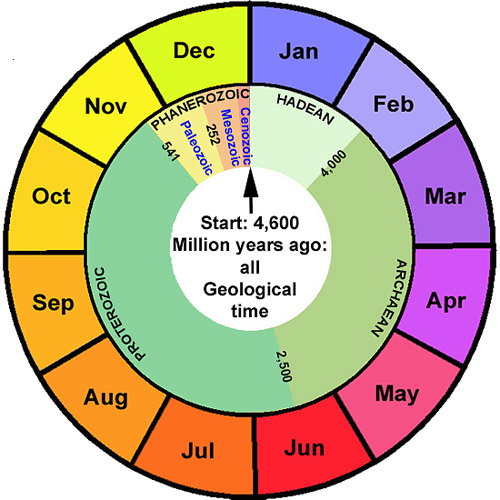
During the late Pliocene and early Pleistocene Series of the Cenozoic Era, 3.6 to 2.2 Ma (million years ago), the Arctic was much warmer than it is at the present day (with summer temperatures from 3.6-3.4 Ma some 8oC warmer than today). That is a key finding of research into a lake-sediment core obtained in Eastern Siberia, which is of exceptional importance because it has provided the longest continuous late Cenozoic land-based sedimentary record thus far. The sedimentary sequence dates from recent times back to 3.6 Ma when the lake was formed by a large extraterrestrial impact. During the warm period, atmospheric carbon dioxide concentrations were close to those of today, at around 400 parts per million, indicative of a strong climate sensitivity signal in the Arctic, which has again warmed very rapidly in recent decades. The lake sediment record has thus provided us with a snapshot of how the Arctic may look in the near future.
Geologists divide geological time into Eons (the longest divisions), Eras, Systems and Series. The Pliocene (5.333-2.588 Ma) is the final Series of the Neogene System and the Pleistocene (2.588 Ma-11,700 years ago) is the first Series of the Quaternary System, both being part of the Cenozoic Era, the latest Era of the Phanerozoic Eon.
Just to get that into context, here is all of geological time plotted against the human 12-month calendar year, so that geological time starts on the first second of New Years' Day and the present is the last second of New Years' Eve. On such a scale, the whole Cenozoic Era equates to a tiny bit of late December!

So let's zoom in by doing the same exercise just with the Cenozoic Era. Now the Pliocene and Pleistocene Series occupy December, although the most recent Series, the Holocene - from 11,700 years ago to now - is such a short timeframe that it remains invisible in among the last seconds of New Years' Eve!
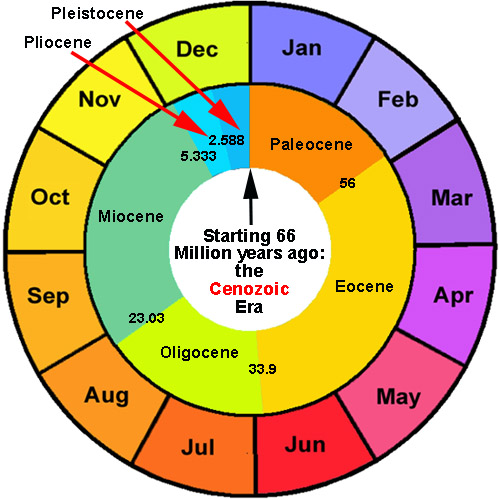
Numbers: millions of years ago. Data: International Commission on Stratigraphy. Graphics: author.
To set the scene, the Pliocene and Pleistocene Earth had a very similar geography to that of the present day in terms of the distribution of continents, with the closure of the Panama Isthmus, forming a land-bridge between North and South America, being a significant development around 3 Ma. The cooling climatic trend that had been underway since the early Oligocene (33 Ma) continued down into the alternating series of glacials and interglacials later in the Pleistocene. Pliocene and early Pleistocene sea levels were significantly higher than those of the present day, with marine sedimentary rocks belonging to this time occurring on land in various parts of the world. Here in the UK, the lower Pleistocene Red Crag Formation, with a well-preserved fossil fauna of bivalves and other shells, many of familiar types, forms extensive cliffs along parts of the East Anglia coast, bearing testament to those higher sea-levels.
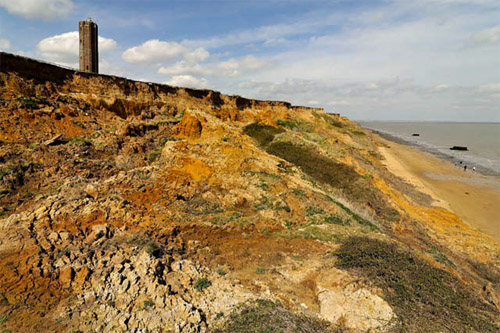
above: landslip-prone cliffs of lower Pleistocene Red Crag Formation, Walton-on-the-Naze, Suffolk, UK. Photo: author.
The cooling occurred gradually and in a stepped fashion. Warmer and cooler periods, but with an overall cooling trend, occurred throughout the Pliocene and up until the so-called Mid-Pleistocene Transition on cycles of ~41,000 years: the cyclic pattern being due to orbital or Milankovitch Cycles. Following the Mid-Pleistocene Transition, a 100,000 year glacial-interglacial cycle predominated.
The cyclic, alternating warm and cool periods each left their mark on the marine oxygen isotope record, something that was first predicted in a 1947 paper by chemist and paleoclimatology pioneer Harold Urey. Oceanic sediment cores show that the ratios of the isotopes oxygen 16 and 18, as measured in the calcite shells of fossil foraminifera, vary through geological time with temperature. This is because oxygen 16 (in water vapour) is more easily lost to the atmosphere during ocean evaporation: in turn, during cold cycles, much more of it gets trapped in snow and ice. Hence, the O16/18 ratio varies at any given time depending on the volume of ice present on the planet.
Via the detailed record of warm and cool climatic stages that has been reconstructed using oxygen isotope data going back through time, each warm or cool period has been given a Marine Isotope Stage number, starting with the present Interglacial, which is Marine Isotope Stage 1. Because the sequence begins with a warm stage, other warm stages have odd numbers and cool stages have even numbers. It's worth mentioning what these Stages are because they are referenced so frequently in the research itself.
Lake El'gygytgyn, pronounced El-Guh-Git-Kin (but commonly called 'Lake E'!) is located in the northeast Russian Arctic, 100 kilometres north of the Arctic Circle. It was formed at 3.6 Ma when an extraterrestrial object estimated to be about 1km in diameter impacted, blasting out a crater some 18 kilometres in width. After the impact, the crater filled with water and sedimentation commenced. The lake is up to 170m deep and beneath its floor there occur bedded lake sediments some 300m in thickness that cover the impact-shattered volcanic rocks (termed impact-breccia), of Cretaceous age. For a detailed geological description of the crater, the following reference gives an interesting read:
http://www.geo.umass.edu/lake_e/publications/Gutrov2007.pdf
Skeptical Science has covered research at this lake before here, but on May 9th 2013 a new paper was published in the journal Science that gives more details of the core and the paleoclimatic evidence it is yielding up. Written by an international team (lead writer: Julie Brigham-Grette of the University of Massachusetts Amherst), the paper describes how drilling was done from an artificially-thickened ice-platform on the lake early in 2009, with resultant cores covering a complete 3.6 million year record spanning 318m of sediments. That is an impressive accomplishment: the record preserved by the Greenland ice, as sampled by ice-coring, stretches back no more than ca. 140,000 years.
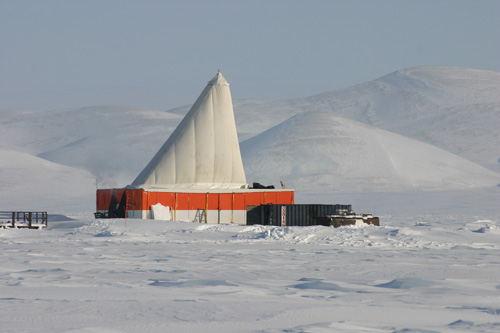
above: the 100-ton drilling-rig on the lake. The ice had to be artificially thickened to over 2m in order to safely take the weight. Photo: Jens Karls.
The part of Siberian Russia in which the lake is situated is one of the few areas of the Arctic that were not glaciated (and thereby glacially eroded) during the later Pleistocene glaciations. This is why the sedimentary record is so well-preserved at 'Lake E': glaciers are thuggish things that move lots of boulders and other heavy debris around, so only non-glaciated environments have much chance of staying undisturbed for such a long time.
The drillcore revealed that the lake sediments are pelagic in nature, i.e. they were deposited very slowly as fine, clay-sized sediment particles settled out of suspension. Think of how a muddly puddle slowly clears up if left undisturbed and you have the picture. Sediment would have been supplied via the streams that flow into the lake and by windblown dust.
For the first ca. 20,000 years following the impact, the sediments reveal few signs of life, but after that there exists a rich assemblage of fossil pollen. The pollen allowed the team to reconstruct the types of vegetation living around the lake, and how it changed through time in response to changes in temperatures and precipitation. Many plants that thrived there in the past, such as the Douglas Fir and Hemlock that are typical of Boreal forests, do not do so today: the area is currently tundra dominated by mosses with stunted trees such as prostrate willow and dwarf birch and is underlain by permafrost.
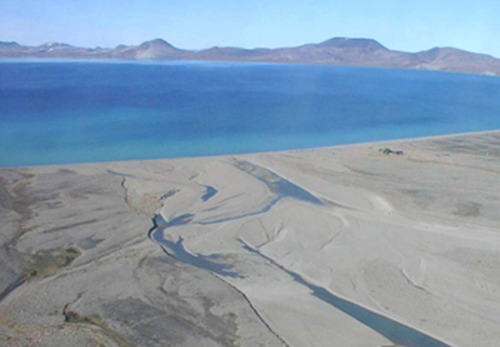
above: Lake El'gygytgyn in the summer. Photo: Julie Brigham-Grette
The paper reports that the pollen reconstructions show that the climate of the area in the middle Pliocene, between 3.6 to 3.4 Ma, was much warmer than that of today. The mean temperature of the warmest month of the year was +15-16oC compared to +8oC today. Rainfall, indicated by the influx rates of sediment, was also substantially greater in the past at 600mm/year compared to the 200m/yr average of today.
Cooling events did occur during the late Pliocene: the largest occurred between 3.31 and 3.28 Ma, when steppe-like habitats developed around the lake. This event, a punctuation mark in the overall warm theme, is thought to have been related to a period in which the influence of the North Atlantic Current declined significantly. However, from 3.26 to 2.6 Ma, warm and moist conditions prevailed, with warmest month temperatures 3-6oC greater than those of today.

above: sections of drillcore from Lake El’gygytgyn. Five distinct facies (sediments with specific sets of characteristics) are present. Facies A, only noted at intervals during the Pleistocene, was deposited in the presence of perennial lake-ice cover. Facies D and E are restricted to the Pliocene. Image from the supplementary material for Brigham-Grette et al, 2013.
The first sign in the lake sediments of cyclic cold spells (glacials), driven by changes in insolation via the orbital Milankovitch Cycles, appears at 2.6 Ma, with such conditions becoming relatively common from 2.3 Ma onwards. The indicator is a change in sediment characteristics (termed 'facies') indicative of the periodic development of year-round lake ice-cover. However, only from 1.8 Ma onwards do all cold cycles produce sediments indicative of perennial ice cover. Thus, the transition from the warmth of the Pliocene down into the cold of the later Pleistocene occurred in a stepwise fashion. The stepwise pattern was also reflected by the vegetation: conifers disappear from the record at 2.71-2.69 Ma and the period 2.6 through to 2.53 Ma saw the transition from forest to a treeless, shrubby environment as the protracted warmth came to an end. By 2.2 Ma, Arctic summers during the warm cycles were - predominantly - no warmer than at present.
That these initial cold cycles were not as drastic as those later in the Pleistocene is also evidenced by sea level variability across individual cycles of only ~70m, compared with ~125m for Marine Isotope Stage 2 - the last glacial maximum.
Another interesting discovery that warrants inclusion in this piece, although it features in an older (2012) paper by the same team, is that 'Lake E' also records the fact that during the Pleistocene there occurred a number of 'super-interglacials'. An example is Marine Isotope Stage 31 which occurred at about 1.07 Ma and in which temperatures in the area were some 4-5oC warmer than present. Climate simulations have difficulty in producing such a degree of warmth with the then greenhouse gas and orbital (Milankovitch) forcings alone, suggesting there must be some other factor at work, such as amplifying feedbacks.
The fact that the sheer amount of Arctic warming that occurred exceeds that simulated by climate models is both interesting and somewhat worrying: Arctic Amplification has only emerged as a realtime signal in recent years and, as the graph below indicates, modelling has not handled its effects particularly well with Arctic sea-ice degradation being a classic example.
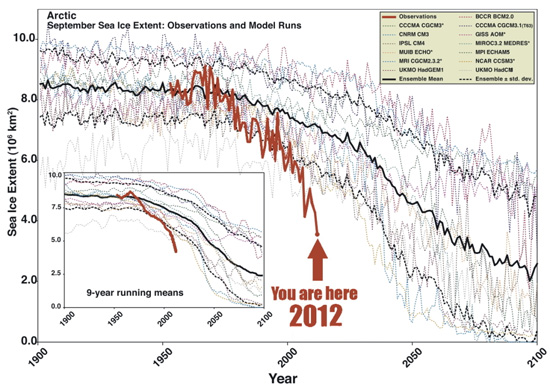
above: observed Arctic sea-ice extent (thick maroon line), with the other lines being modelled forecasts and the thicker black line being their mean. When someone tells you that the models don't get it right, it's worth pointing out that this works both ways!
At the other end of the world, investigations into this 400ppm carbon dioxide world of the past have yielded other indications of the type of world we are heading into. Sediment cores obtained during the ANDRILL drilling programme yielded results with which the 'Lake E' data are in good agreement. Writing in Nature in 2009, concerning an early (5-3 Ma) Pliocene Antarctic sediment core section, Naish et al note:
Our data provide direct evidence for orbitally induced oscillations in the WAIS [West Antarctic Ice-Sheet], which periodically collapsed, resulting in a switch from grounded ice, or ice shelves, to open waters in the Ross embayment when planetary temperatures were up to approx 3 °C warmer than today and atmospheric CO2 concentration was as high as approx 400 p.p.m.v.
A second 2009 paper in Nature compared simulations of past Antarctic ice-cap behavour with the sedimentary history obtained from drillcore and determined that the West Antarctic Ice-Sheet had undergone major and perhaps total retreat during Marine Isotope Stage 31 and in other super-interglacials. The fact that there exists strong evidence for past major warming and its consequences in both polar regions suggests an interconnectivity between the poles, with the implication that these are effects occurring on a global scale.
2013 almost certainly marks the first year, since the Pliocene, in which rising carbon dioxide concentrations have breached the 400ppm milestone. What next? As Julie Brigham-Grette notes:
"This could tell us where we are going in the near future. In other words, the Earth system response to small changes in carbon dioxide is bigger than suggested by earlier climate models."
To conclude, the Arctic climate response to warm forcing agents is to warm more than models would predict, with other poorly-constrained amplifying feedbacks the likely culprits, and what goes on in the Arctic tends to be reflected in due course by what goes on in the Antarctic. Past warming events during the Pleistocene and Pliocene have seen ice-cap collapse in both areas. Readers will be familiar with the figures: it is estimated that the collapse of the West Antarctica and Greenland ice-sheets would lead to getting on for fourteen metres of sea-level rise over a number of centuries. The results of the studies discussed above show that such events are compatible with a world in which the atmosphere contains ~400ppm of carbon dioxide. How, then, will Marine Isotope Stage 1 (the current interglacial) pan out? It's up to us to decide that one.
Posted by John Mason on Tuesday, 14 May, 2013
 |
The Skeptical Science website by Skeptical Science is licensed under a Creative Commons Attribution 3.0 Unported License. |